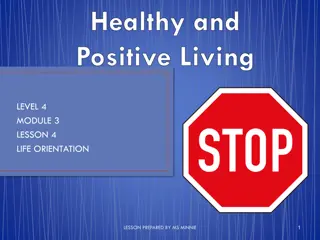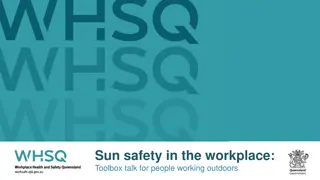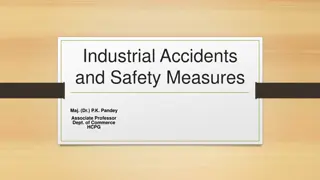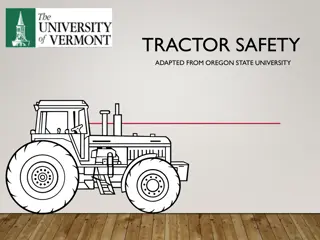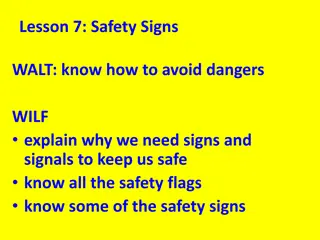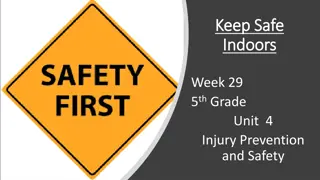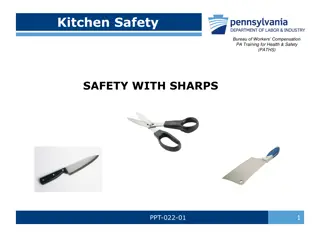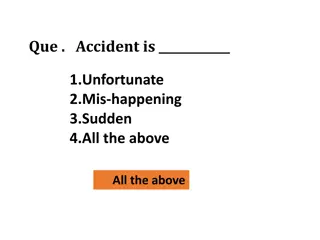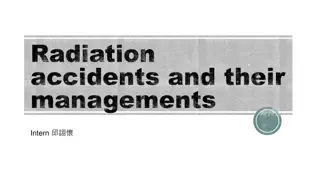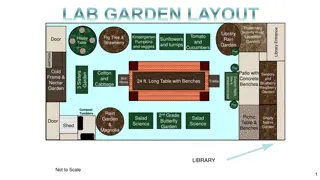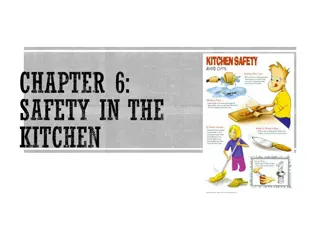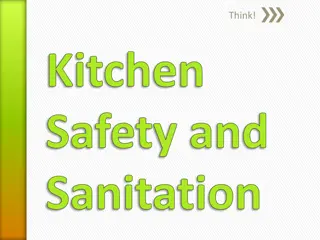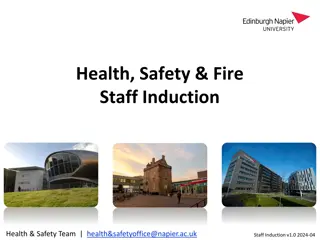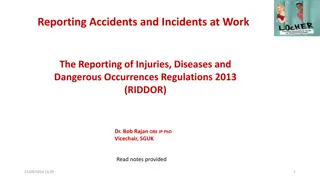Garden Safety Tips: Prevent Accidents and Stay Safe Outdoors
Learn essential garden safety tips to prevent accidents while working in the garden. From wearing appropriate footwear to using the right tools, follow these guidelines for a secure gardening experience. Stay safe and enjoy your time outdoors without coming a cropper!
Download Presentation

Please find below an Image/Link to download the presentation.
The content on the website is provided AS IS for your information and personal use only. It may not be sold, licensed, or shared on other websites without obtaining consent from the author. Download presentation by click this link. If you encounter any issues during the download, it is possible that the publisher has removed the file from their server.
E N D
Presentation Transcript
Swiss Council for Hodlerstrasse 5a, 3011 Berne Accident Prevention info@bfu.ch bfu.ch Company, event, date Name Don t come a cropper in the garden
Statistics Every year, around 14,000 people are injured while working in the garden. 2
General safety pointers Allow enough time. Prepare yourself for your work. Wear sturdy, closed footwear with heavy-duty soles. When working in the garden, ensure that you have a stable footing and sufficient freedom of movement. Depending on the work and the garden tool, always wear the appropriate personal protective equipment (safety glasses, gloves, hearing protectors and/or protective face mask). Quelle: bfu.ch/produkte 4
General safety pointers Select the appropriate garden tool for the intended purpose. Use a stable ladder when working at a height. Use a residual current device (RCD) when working with electrical power tools. 5
Flying high but safely Use a stable ladder for working at heights (SN EN 131). Choose the right ladder for your work. Wear sturdy, non-slip footwear. Only set up ladders on level, solid and non-slip surfaces. Secure the foot of the ladder to prevent slipping (anti-slip feet, tips on the spars or guide boards). 6
Flying high but safely Only place leaning ladders against safe support points and secure them at the top, e.g. by lashing them with a rope/tensioning strap to prevent them from slipping sideways. The ideal angle for setting up a ladder is approximately 70 . Set up stepladders in such a way that the spreader device is effective. Do not use stepladders as leaning ladders. Always climb a ladder with your face to the ladder and your hands on the rungs. 7
Flying high but safely Keep both feet on the rungs and do not lean excessively to one side. Never work on the top three rungs. Only carry out light tasks on a ladder. Give ladders regular visual and thorough checks at least once a year. Have a defective ladder repaired or replaced immediately. A ladder is not always necessary. Small trees or shrubs can be cut from the ground with telescopic lopping shears. 8
Take care when working with power tools Before using a machine or power tool, read the operating instructions and familiarise yourself with any possible dangers. Check the tools for safety before use: Cable and plug undamaged? Accessories close to hand? Tools well sharpened and clean? 9
Take care when working with power tools Do not remove any safety devices. Keep other people (especially children) away from the work area. Never leave a device that is ready for use unsupervised. Disconnect the mains plug from the socket or switch off the motor or, in the case of internal combustion engines, remove the spark plug connector when work is interrupted or the tool is being cleaned. Have faulty machines and power tools repaired by a professional. 10
Specific pointers on electrical power tools Never use electrical power tools in the rain. Only use power cables that are suitable for outdoor use. Power supplies for outdoor use must be protected by RCDs (residual current devices). Make sure that power tools are switched off before being connected to the power supply/battery. Quelle: bfu.ch/produkte 11
Specific pointers on electrical power tools Use a cable reel designed for use with lawnmowers. Pay attention to cable routing to ensure that the power cable does not get into the working area. Make sure that the power cable has a conspicuous colour that stands out well (for example, red or orange). Use cable retainers on the tool and on the strap. 12
Specific pointers on tools powered by internal combustion engines Only use these tools outdoors. Only refuel them when they have cooled down and use a suitable filler spout. Store petrol/gasoline in dedicated containers. Caution: Internal combustion engines heat up quickly (risk of burns). 13
Lawnmowers Wear sturdy, closed shoes, long trousers, safety glasses, protective gloves and possibly hearing protectors. Before mowing, remove any foreign objects from the area, such as stones, branches, toys or decorative material. Mow across the slope when the lawn is on a gradient. Only mow forwards. There is a greater risk of tripping when mowing backwards. Never reach under the casing while the motor is running disconnect the plug, switch off the engine. 14
Garden strimmers Always wear sturdy, high footwear (boots), long clothing, safety glasses with side protection, gloves and possibly hearing protectors. Before mowing, remove any foreign objects from the area, such as stones, branches, toys or decorative material. Adjust the handles and carrying strap to suit your body size. Always hold garden strimmers with both hands. Mow across slopes. Only adjust the length of the line when the tool is switched off (if possible, purchase a model with automatic line readjustment). 15
Hedgecutters Always wear sturdy, closed footwear (boots), long clothing, safety glasses with side protection, protective gloves and possibly hearing protectors. Check the hedge for foreign bodies such as, for example, wire or lanterns. Use a tool with two-hand safety circuitry. Always hold the tool with both hands. Pay attention to hazardous locations/areas (for example, proximity to road traffic) 16
Shredders Always wear sturdy, closed footwear, long clothing, safety glasses with side protection, protective gloves and possibly hearing protectors. Ensure that the surface of the working area is firm and level. Make sure that the ejector chute is always unobstructed; this reduces the risk of clogging. Before inserting any material for shredding, wait until the machine has reached full speed after being switched on. Do not reach into the feed hopper. Use a wooden pusher or a slider to push in the material for shredding. 17
Use chemical products safely Check whether the use of garden chemicals is really necessary; inquire about alternatives. Only use, store and dispose of garden chemicals strictly according to instructions. Pay attention to the hazard symbols and notes on use on the packaging. 18
Use chemical products safely Wear gloves, safety glasses and, if necessary, a respirator and long-sleeved clothing when using chemical products. Always store chemicals in their original containers and under lock and key in a suitable cabinet. Hazardous substances must be kept out of children s reach. 19
When gardening is finished Clean and check personal protective equipment, garden tools and cables for damage. Never wash off electrical appliances by spraying them with water. Fit protective covers to the exposed cutting edges of garden tools. Ensure that garden tools are stored where they cannot fall over; electrical tools should also be protected from humidity. Always point the spikes, tines and cutting edges of garden tools towards the ground or a wall. Store garden ladders, especially ones made of wood, where they are protected from the weather. 20
More information Follow this link for further tips on accident prevention: bfu.ch. 21



